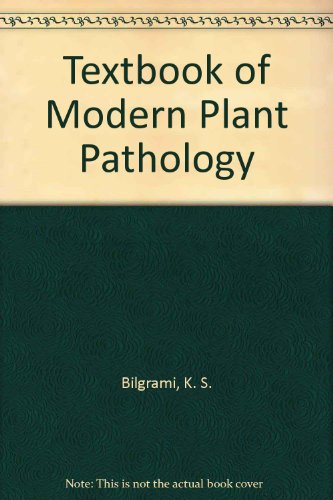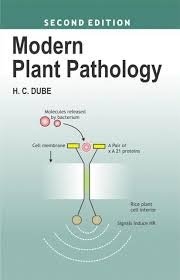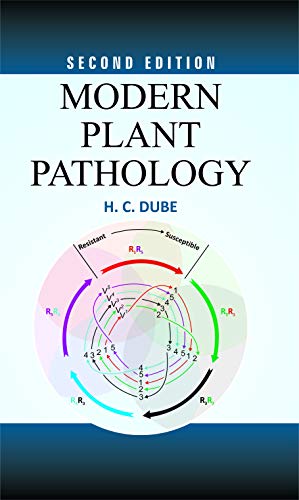Modern Plant Pathology by H C Dube (3 results)
Product Type
- All Product Types
- Books (3)
- Magazines & Periodicals
- Comics
- Sheet Music
- Art, Prints & Posters
- Photographs
- Maps
-
Manuscripts &
Paper Collectibles
Condition
Binding
Collectible Attributes
- First Edition
- Signed
- Dust Jacket
- Seller-Supplied Images
- Not Printed On Demand
Seller Location
Seller Rating
-
Textbook of Modern Plant Pathology
Published by Vikas Publishing House Pvt.Ltd ,India, 1990
ISBN 10: 0706949080ISBN 13: 9780706949087
Seller: Polly's Books, Grand Rapids, MI, U.S.A.
Book
Paperback. Condition: Used: Good. 1979-Reprint. A nice copy with a tight and square binding. No names, no marks, no stickers. Text is clean but lightly yellowed. Covers are good but spine is lightly faded. Careful packaging and fast shipping. We recommend EXPEDITED MAIL for even faster delivery.
-
Modern Plant Pathology (2nd Ed.)
Published by Agrobios (India), 2022
ISBN 10: 8188826650ISBN 13: 9788188826650
Seller: Vedams eBooks (P) Ltd, New Delhi, India
Book
Soft cover. Condition: New. 2nd Edition. The theme of the book is to introduce students to the current intellectual excitement and challenges in studying plant disease and its management. there are exclusive chapters on the infectious pathogens; (fungi, bacteria, fastidious vascular- colonizing bacteria, viruses, sub- viral pathogens, nematodes) and the non-infectious, abiotic agents that causes disorders due to mineral imbalances, ozone, PAN and ethylene. The chemical determinants of pathogenicity and virulence: the cell wall degrading enzymes, plant hormones and toxins are discussed with well documented examples. Disease resistance mechanisms without recourse to antibodies, t-cells and the like are less subtle than the mammalian immune system. these include the pre- existing and those induced after molecular avirulence-, and resistance gene- products viz. the elicitors and resistance proteins, respectively. The role of signal molecules like salicylic acid, jasmonates and ethylene in development of systemic resistance, are discussed in depth justifying their present cutting edge status in plant pathology .The celebrated "gene for gene hypothesis" and the phenomena of recognition, and specificity are described with clarity. The infected plant shows alterations in its physiology and biochemistry, especially in membrane damage, ionic imbalance, respiration, photosynthesis, protein and phenol metabolism. the human efforts in protecting the crop through fungicides, and now more importantly by biological control methods including transgenic resistant cultivars are elucidated. the second half of the book is devoted to description of diseased (their casual agents, symptoms, epidemiology and management) under chapter devoted to leaf - spots and blights, mosaics, leaf curls and yellows wilts, rots, abnormal growths, and the biotrophic diseases , the downy mildews, powdery mildews, and smuts and the rusts.
-
Modern Plant Pathology (2nd edition)
Published by Agrobios, 2022
ISBN 10: 8177545345ISBN 13: 9788177545340
Seller: Vedams eBooks (P) Ltd, New Delhi, India
Book
Hardcover. Condition: New. 2nd Edition. Contents 1. History of plant pathology. 2. Some definitions and concepts. 3. Fungi as plant pathogens. 4. Bacteria as plant pathogens. 5. Fastidious vascular colonizing bacteria. 6. Viruses as plant pathogens. 7. Sub viral plant pathogens (viral satellites viroids and prions). 8. Nematodes as plant pathogens. 9. Angiosperms as plant pathogens. 10. Parasitic green algae and plant pathogens. 11. Noninfectious abiotic plant disease agents (non parasitic or physiological disorders). 12. Cell wall degrading enzymes in plant pathogenesis. 13. Toxins in plant pathogenesis. 14. Disease resistance I Protection. 15. Disease resistance II Defense (Active or induced resistance). 16. Genetics of host parasite interactions and specificity. 17. Physiology of the diseased plant. 18. Plant disease management (Plant Disease Control) I Prevention. 19. Plant disease management (Plant Disease Control) II Cure (Therapy). 20. Chemicals in plant disease management. 21. Leaf spots and blights. 22. Mosaics yellows leaf curls and other abnormalities (Virus and Phytoplasma Diseases). 23. Wilts. 24. Rots Damping off of seedlings soft rots and dry rots. 25. Abnormal growths Galls leafy galls shoot proliferations and fasciations. 26. Downy mildews. 27. Powdery mildews. 28. Smuts and bunts. 29. Rusts. Glossary. Author index. Organism index. Subject index. The theme of the book is to introduce students to the current intellectual excitement and challenges in studying plant disease and its management. There are exclusive chapters on the infectious pathogens the fungi bacteria fastidious vascular colonizing bacteria viruses sub viral pathogens (viral satellites virusoids and the viroids that have paled off viruses into insignificance in their size and ingenuity of parasitism) nematodes and the non infectious abiotic agents that cause disorders due to mineral imbalances ozone PAN and ethylene. The chemical determinants of pathogenicity and virulence the cell wall degrading enzymes plant hormones and toxins are discussed with well documented examples. Disease resistance mechanisms without recourse to antibodies T cells and the like are no less subtle than the mammalian immune system. These include the pre existing and those induced after molecular interactions between avirulence and resistance gene products viz. the elicitors and resistance proteins respectively. The role of signal molecules like salicylic acid jasmonates and ethylene in development of systemic acquired resistance induced systemic resistance and wound induced systemic resistance are discussed in depth justifying their present cutting edge status in plant pathology. In genetics the celebrated gene for gene hypothesis and the phenomena of recognition and specificity are described with clarity. The infected plant shows alterations in its physiology and biochemistry especially in membrane damage ionic imbalance altered respiration photosynthesis protein and phenol metabolisms. The human efforts in protecting the crops through fungicides and now more importantly by biological control methods including transgenic resistant cultivars are elucidated. The second half of the book is devoted to description of diseases (their causal agents symptoms epidemiology and management) under chapters devoted to leaf spots and blights mosaics leaf curls and yellows wilts rots abnormal growths and the biotrophic diseases the downy mildews powdery mildews and smuts and the rusts. 612 pp.




